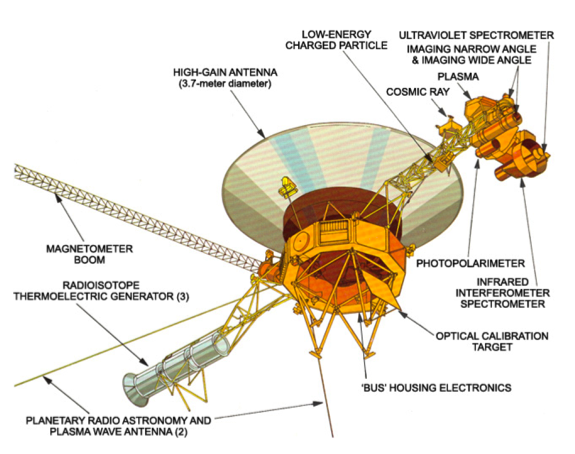- To determine the scattering properties of the lower planetary atmospheres.
- To determine the distribution of constituents with height.
- To determine the extent and distribution of hydrogen corona of the planets and satellites.
- To investigate night airglow and auroral activity.
- To determine the UV scattering properties and optical depths of planetary rings.
- To search for emissions from the rings and from any ring "atmosphere."

Instrument Characteristics
The Voyager 1 Ultraviolet Spectrometer (UVS) is a compact Wadsworth mounted objective grating spectrometer that covers the wavelength range of 0.0535 to 0.1702 micron for Voyager 1 and 0.0513 to 0.1680 micron for the Voyager 2. A mechanical 'collimator’ defines the main 'airglow' field-of-view (FOV) of 0.10 x 0.87 degrees full-width-half-maximum (FWHM). Light passing through the collimator strikes the concave diffraction grating at near normal incidence. The grating disperses and focuses light onto a 1-d array detector that records individual photoevents. An auxiliary field-of-view for solar occultation experiments is offset 20 degrees from the airglow field by a small mirror near the front of the collimator. Using this 'occultation port', UVS can view the Sun without pointing the main field, and those of other coaligned instruments, directly at the Sun. The occultation field is 0.25 x 0.87 degrees. A sunshade prevents illumination of the main entrance aperture by the sun during occultation observations.
UVS Science Objectives
References Helpful in Scoping the Mission
Mission Description
Spacecraft Description
Spacecraft Description
The UVS Data
Maps of Hydrogen Lyman-alpha and Molecular Hydrogen bands derived from Voyager 1 and 2 Ultraviolet Spectrometer (UVS) observations obtained during North/South mapping sequences of Jupiter. The incorporated pointing information has been updated with image navigation techniques (C-smithed). Data are grouped in subdirectories for each of the two planets; within each subdirectory are the data files (further separated by spacecraft) and the associated PDS label files.
Instrument Description
Also see Space Science Reviews 21 (1977)– Issue 2) 183-205.
Data Set Overview
The Data Files are ASCII tables with supporting labels..See vg1_j_ns and vg2_j_ns
Also see Space Science Reviews 21 (1977)– Issue 2) 183-205.
Data Set Overview
The Data Files are ASCII tables with supporting labels..See vg1_j_ns and vg2_j_ns
These volumes contain reformatted Voyager 2 UVS spectral data records with merged ancillary information derived from the footprint SEDR files. All data for which footprint SEDR information was available are included, except for certain high background noise time periods near closest approach to Jupiter.
vg_2204 VOYAGER 2 JUPITER ENCOUNTER:1979-05-25 TO 1979-06-15
vg_2205 VOYAGER 2 JUPITER ENCOUNTER:1979-06-16 TO 1979-07-07
vg_2206 VOYAGER 2 JUPITER ENCOUNTER:1979-07-12 TO 1979-08-11
Other Documentation
Access to the Voyager UVS Data Volume
Publications - A listing of team members to facilitate literature searches.
Observation geometry in "SPICE" format may be obtained at the NAIF node
 PDS: The Planetary Atmospheres Node
PDS: The Planetary Atmospheres Node


